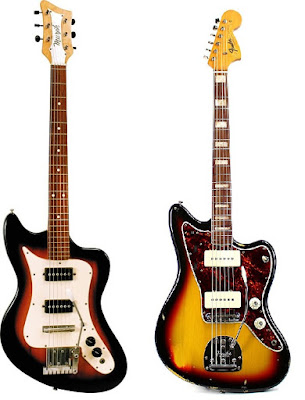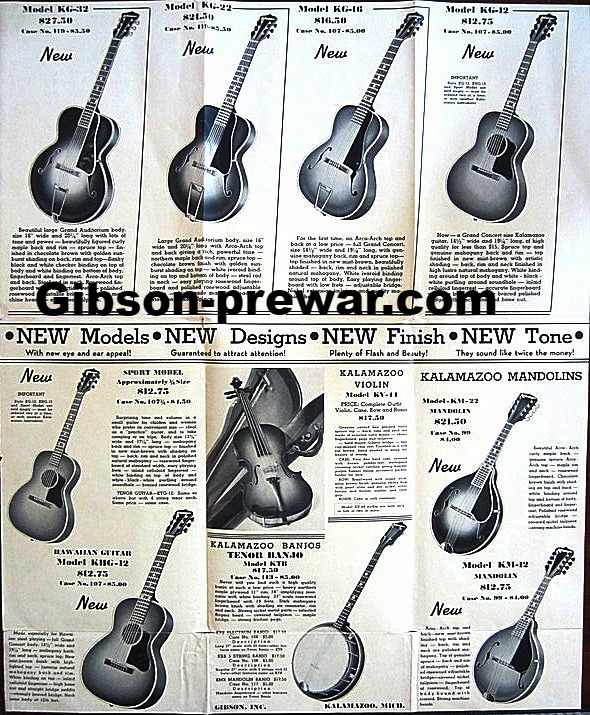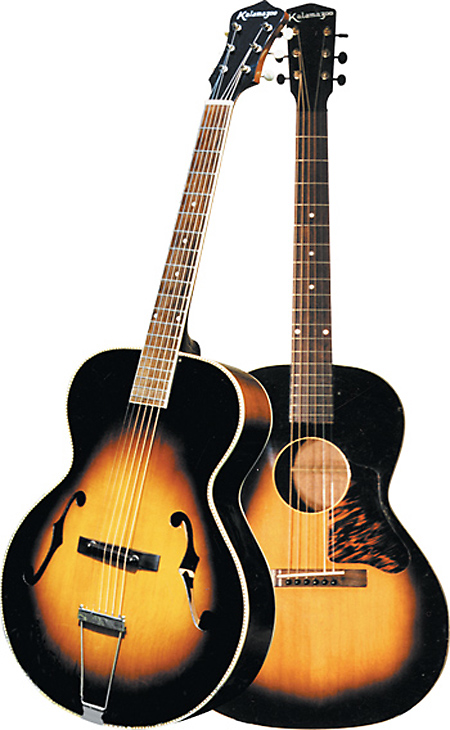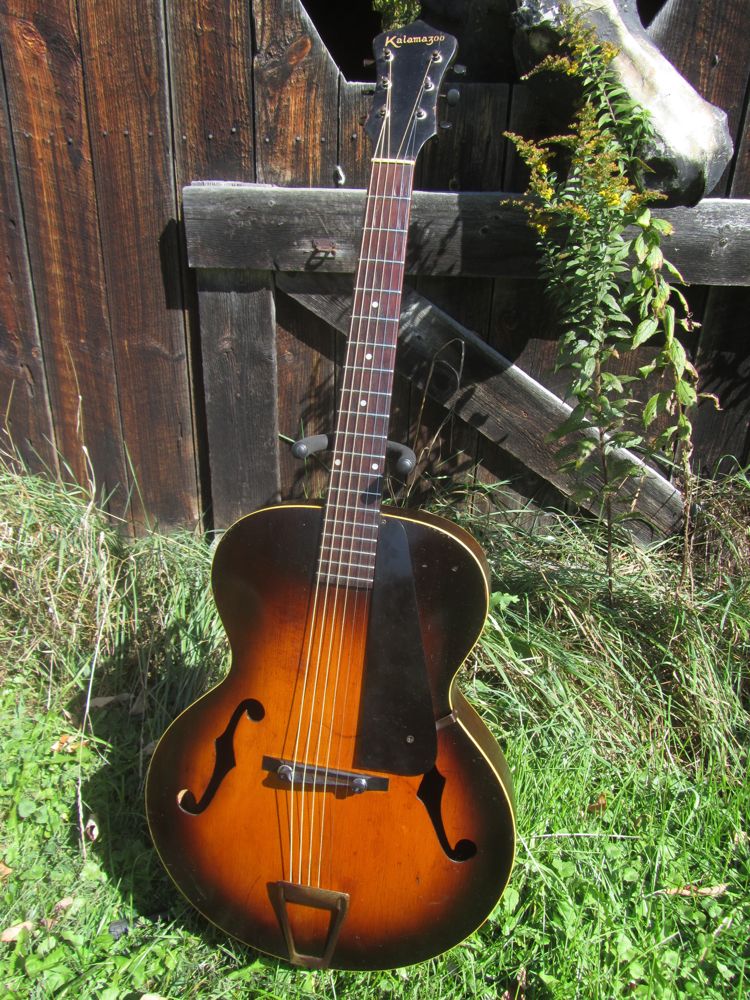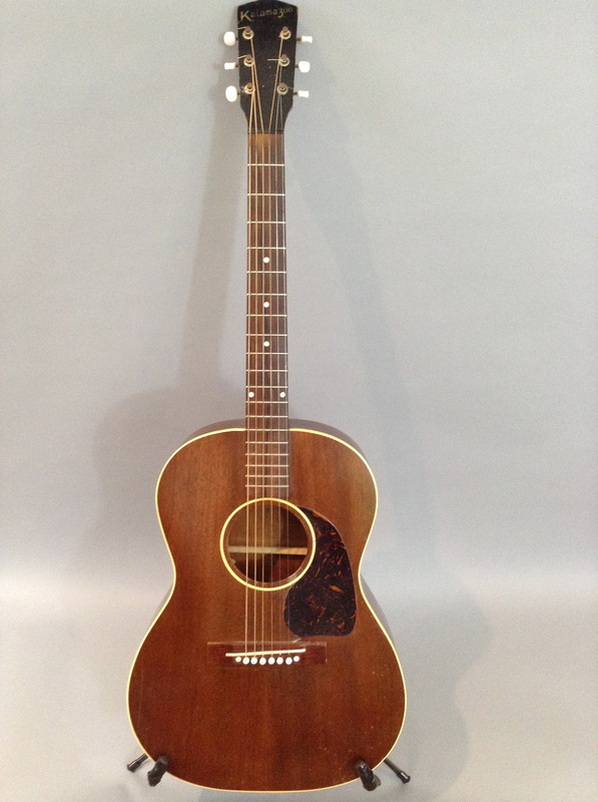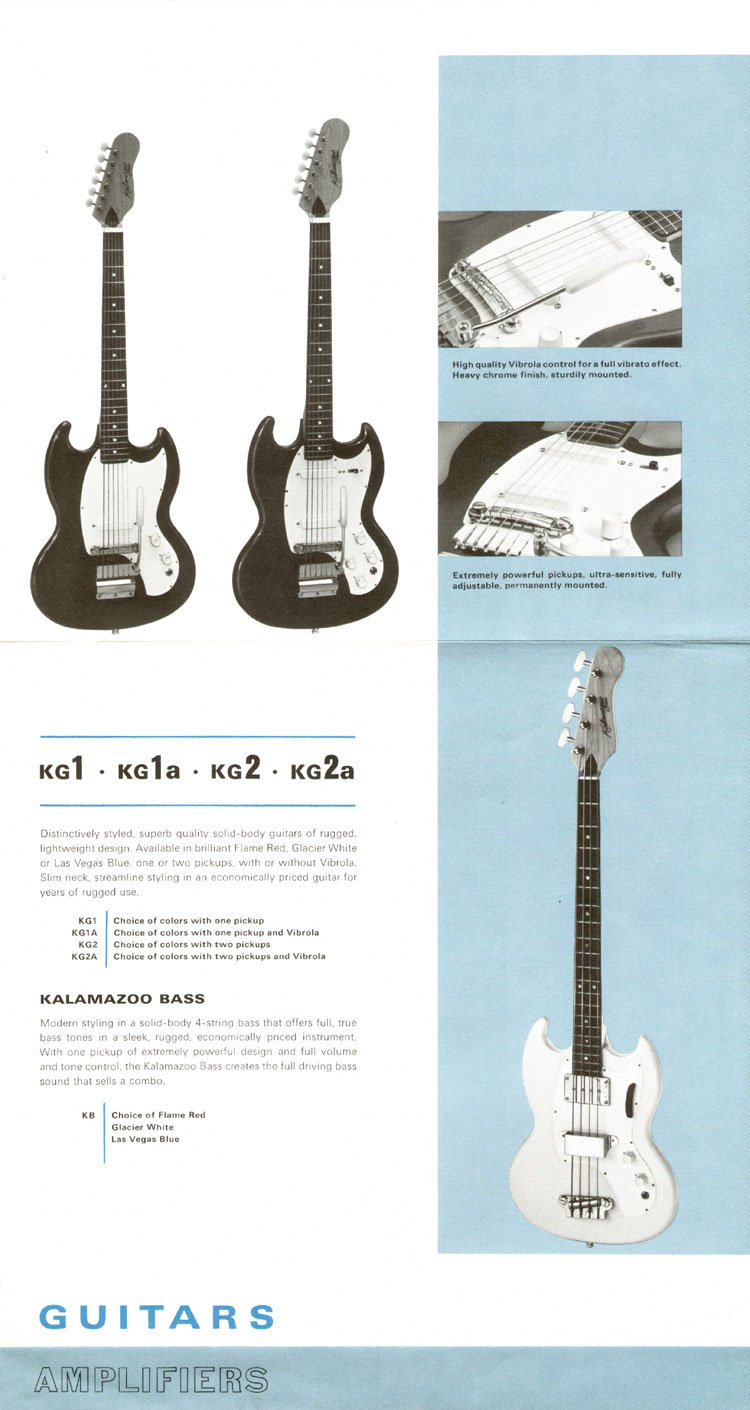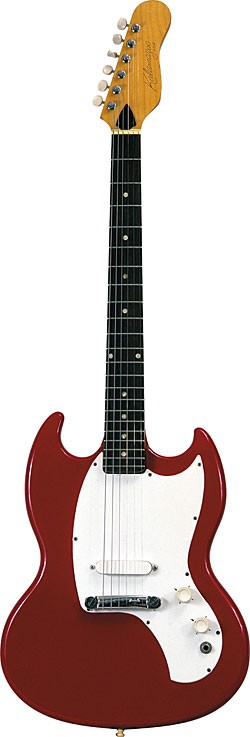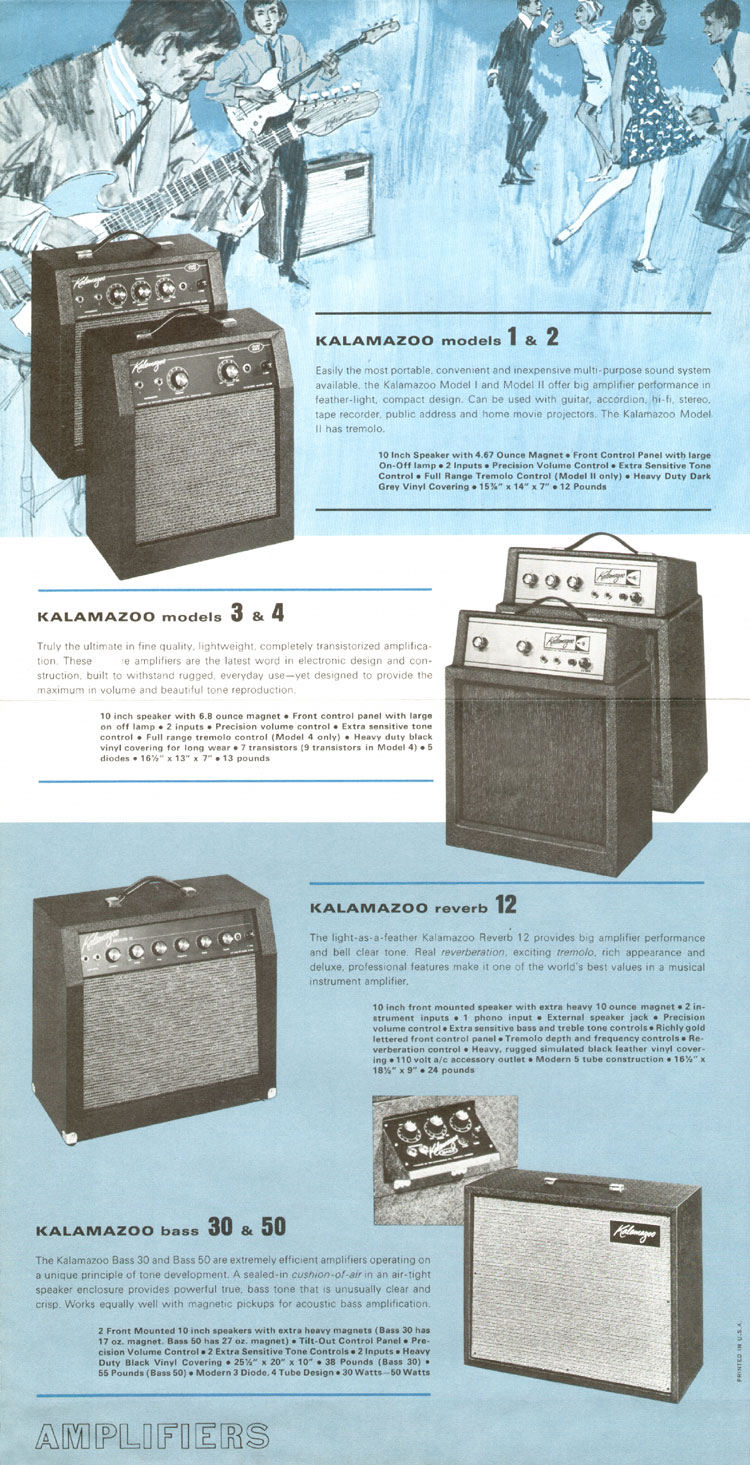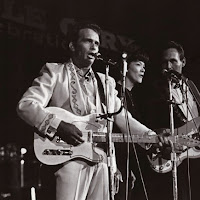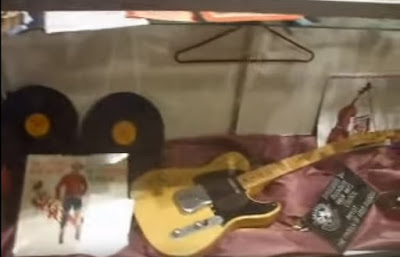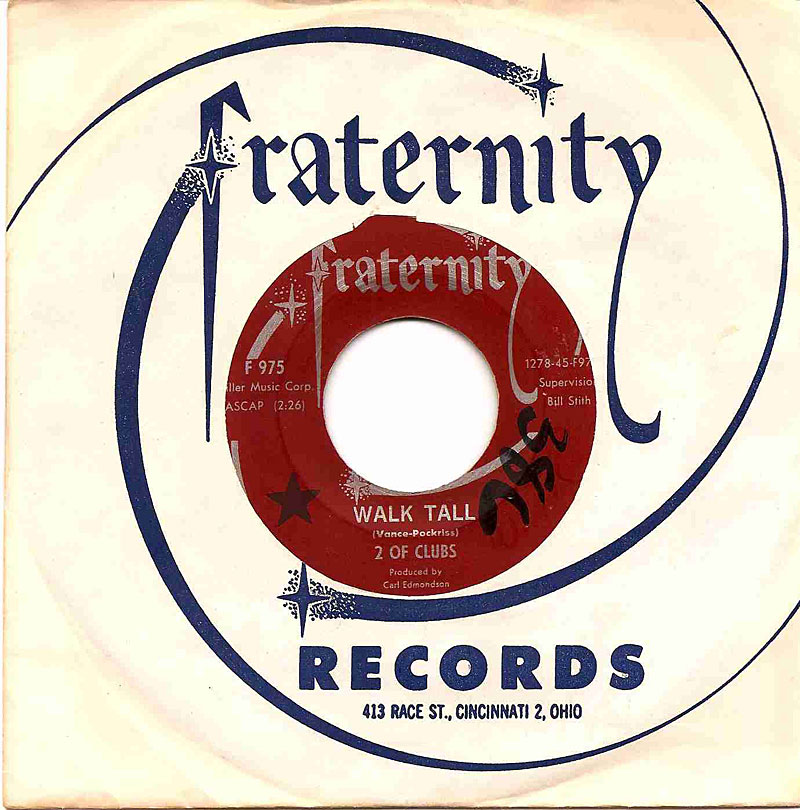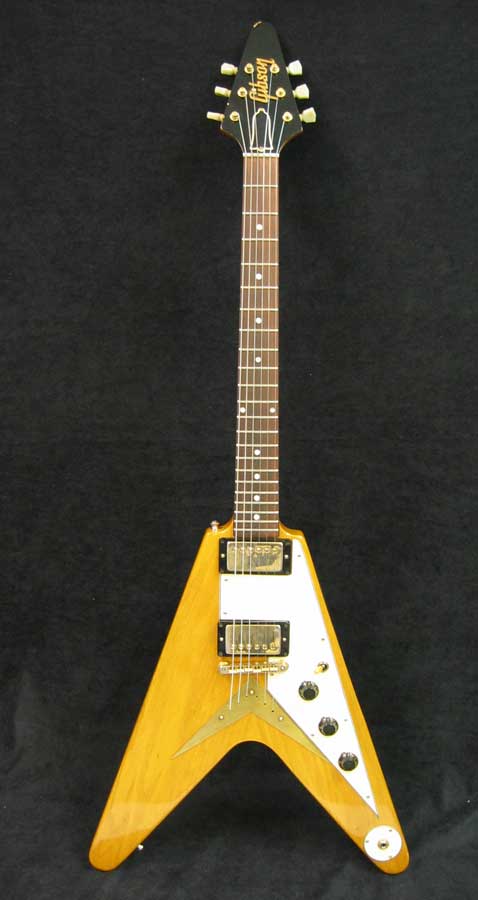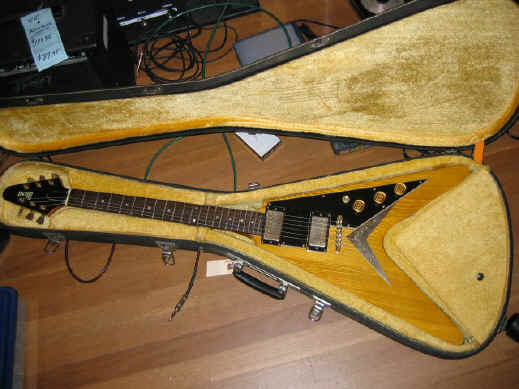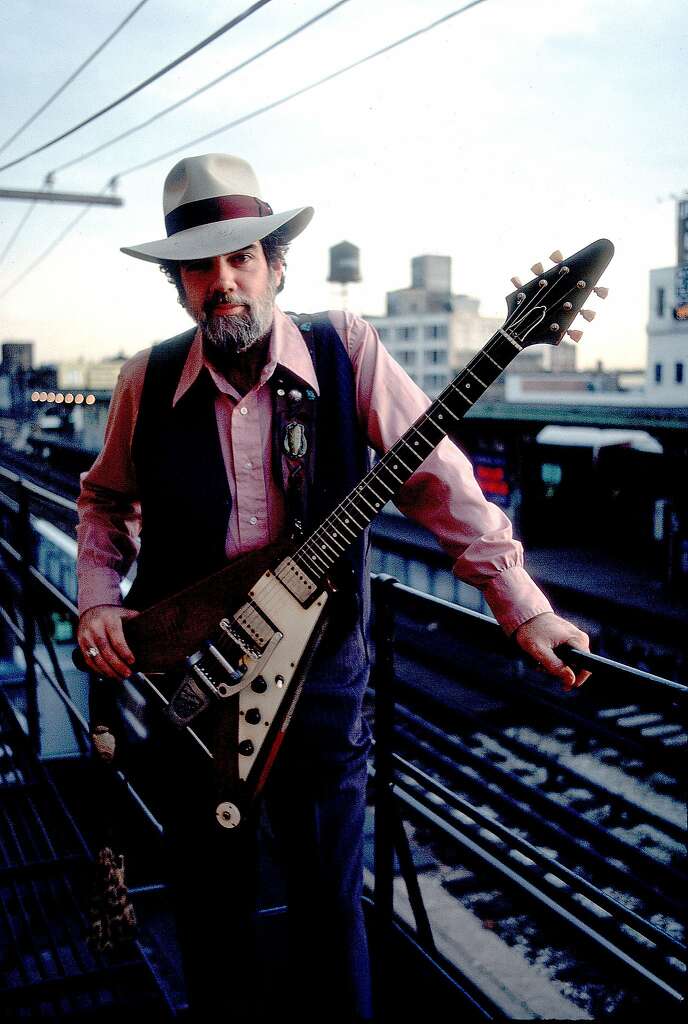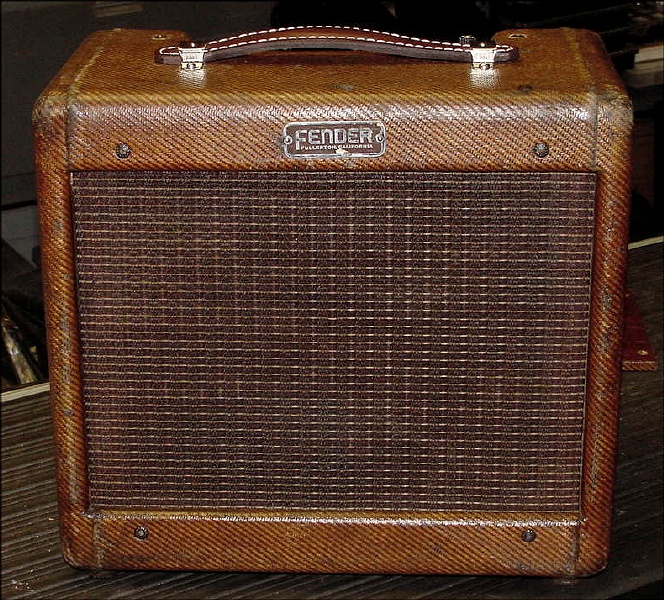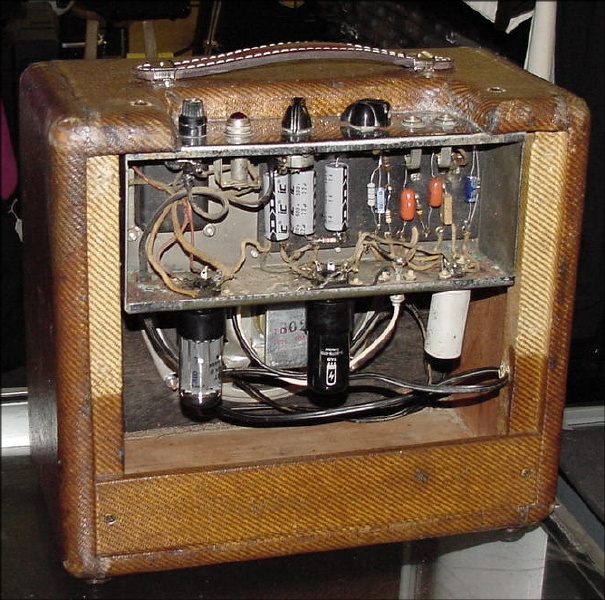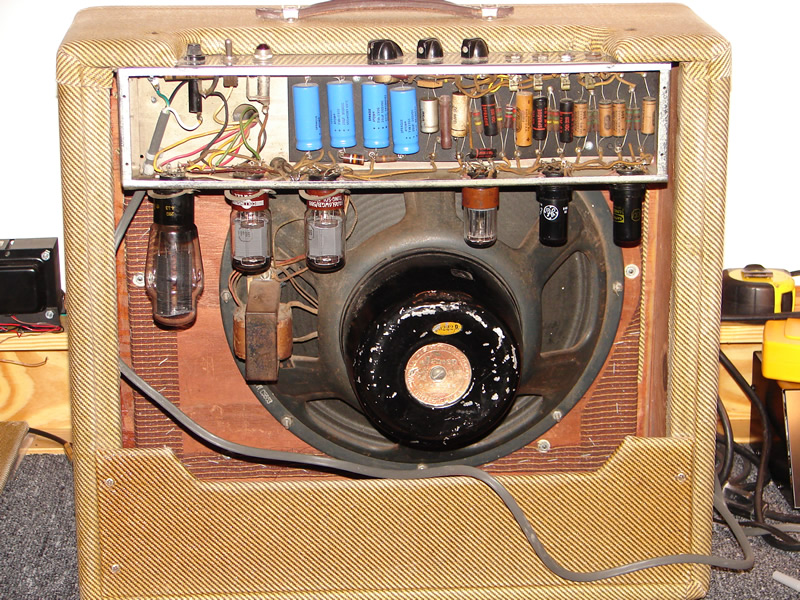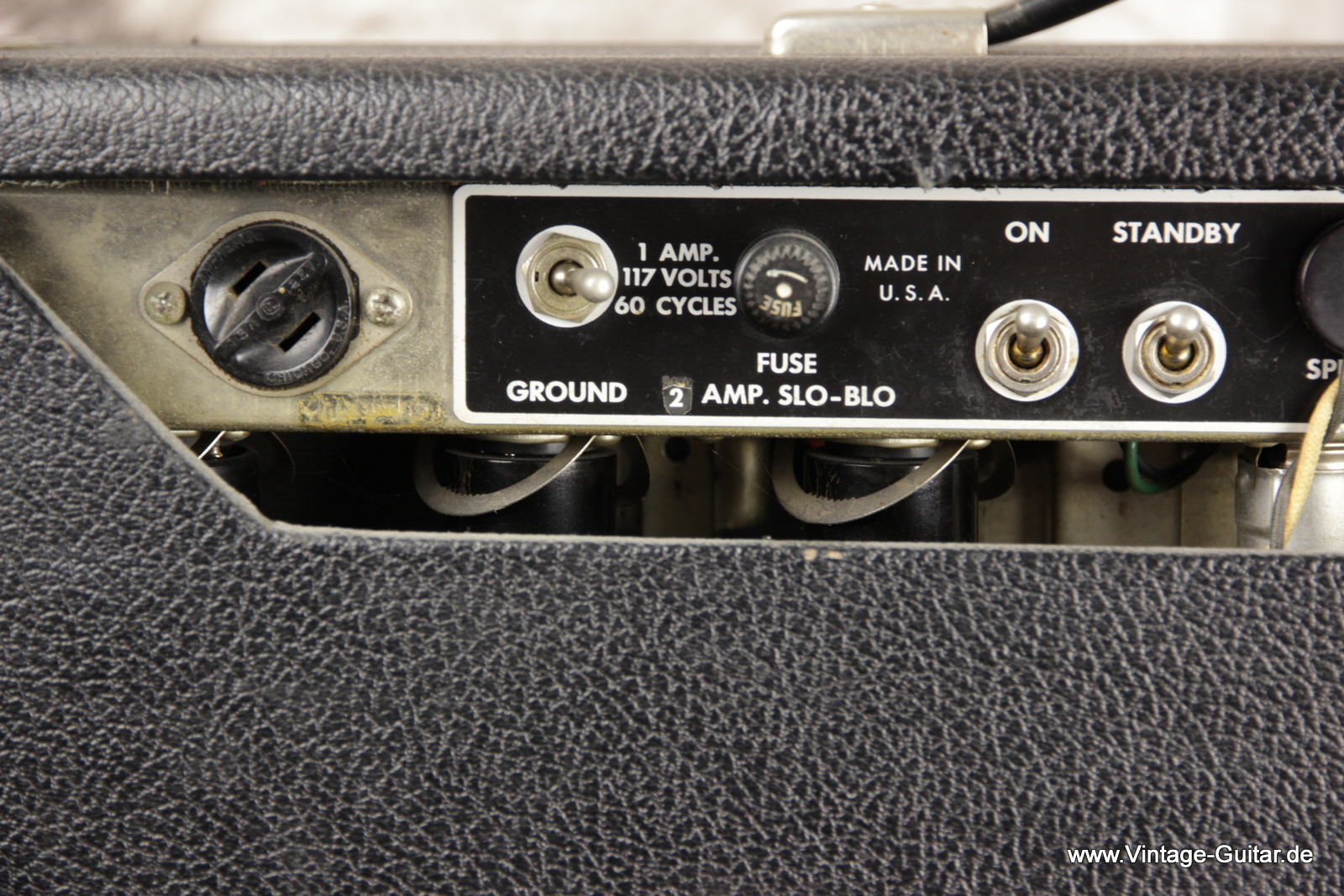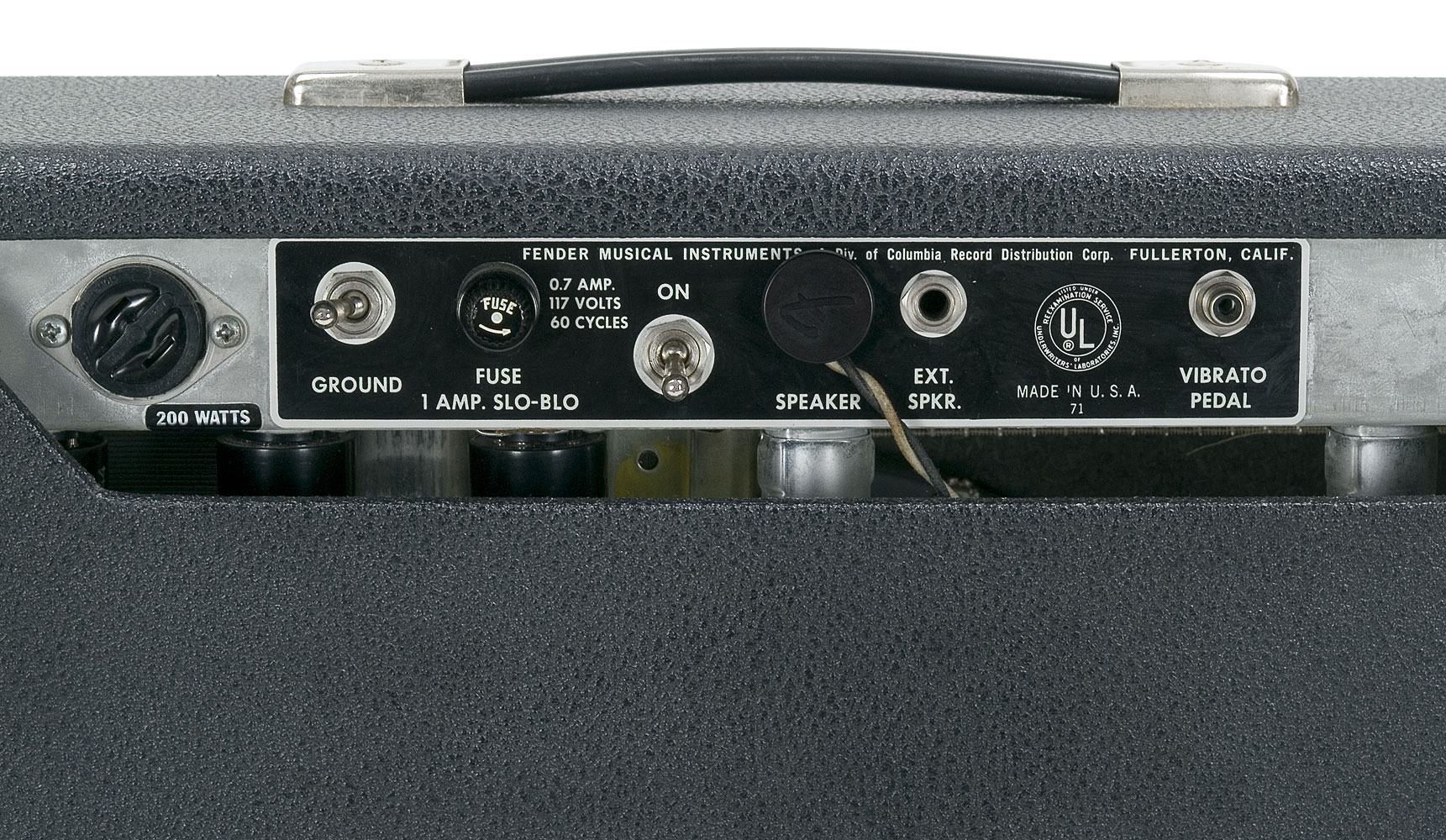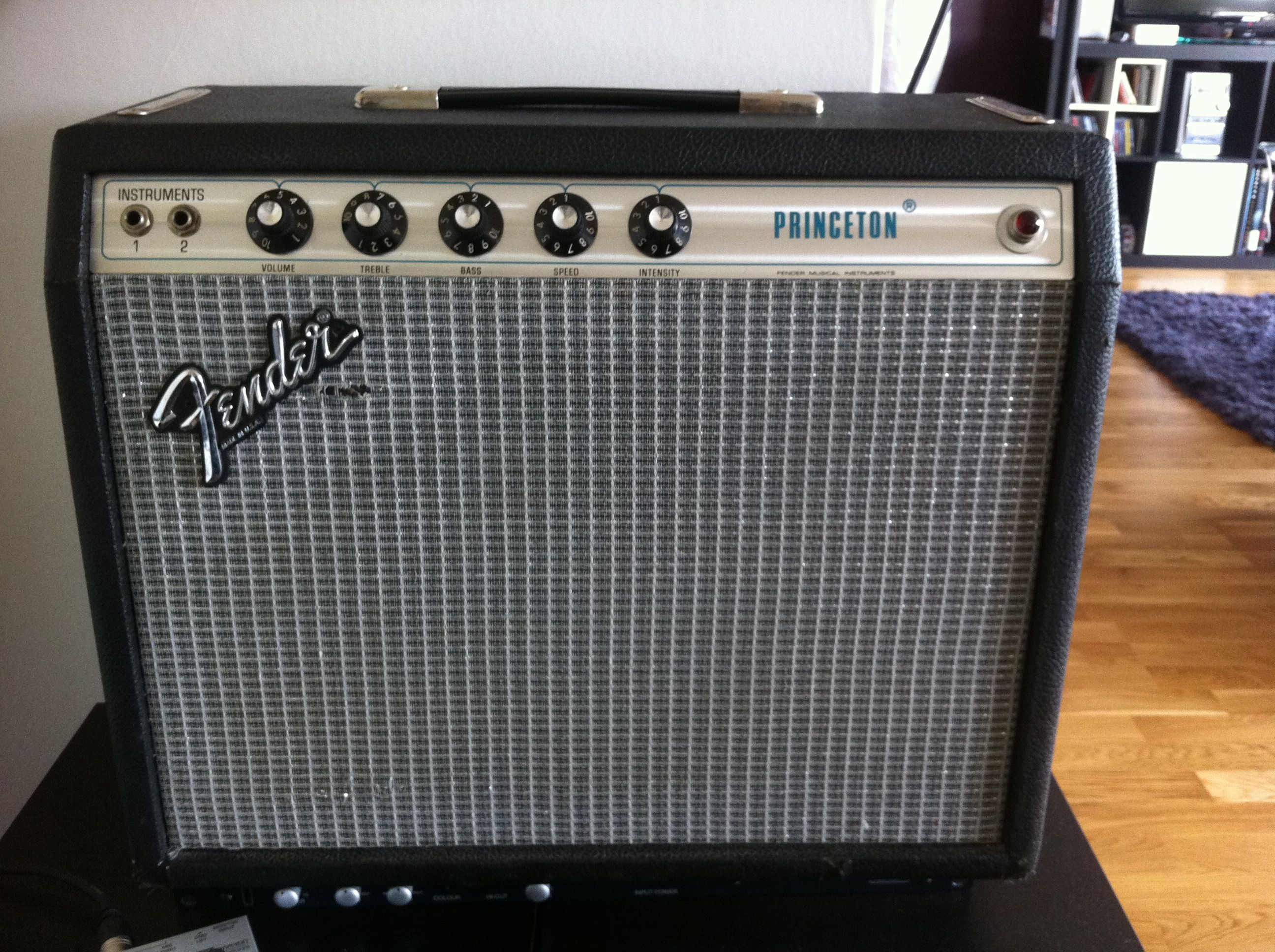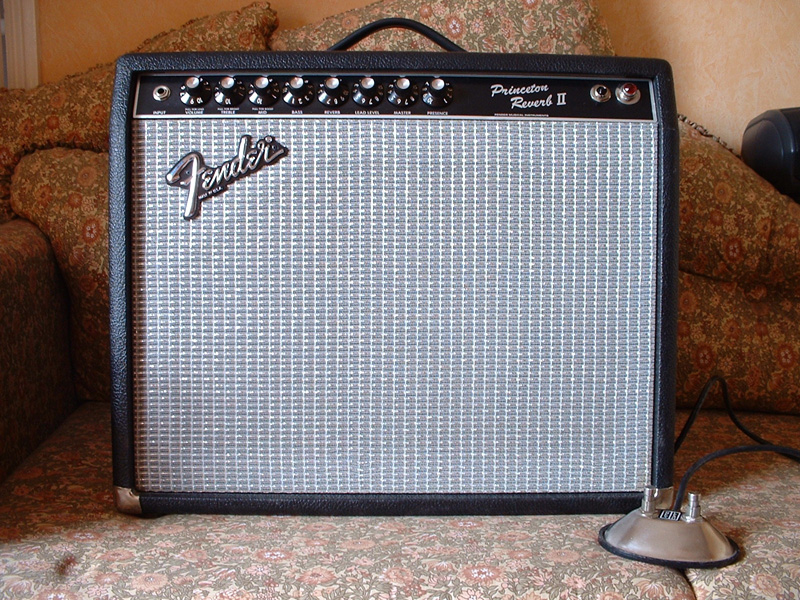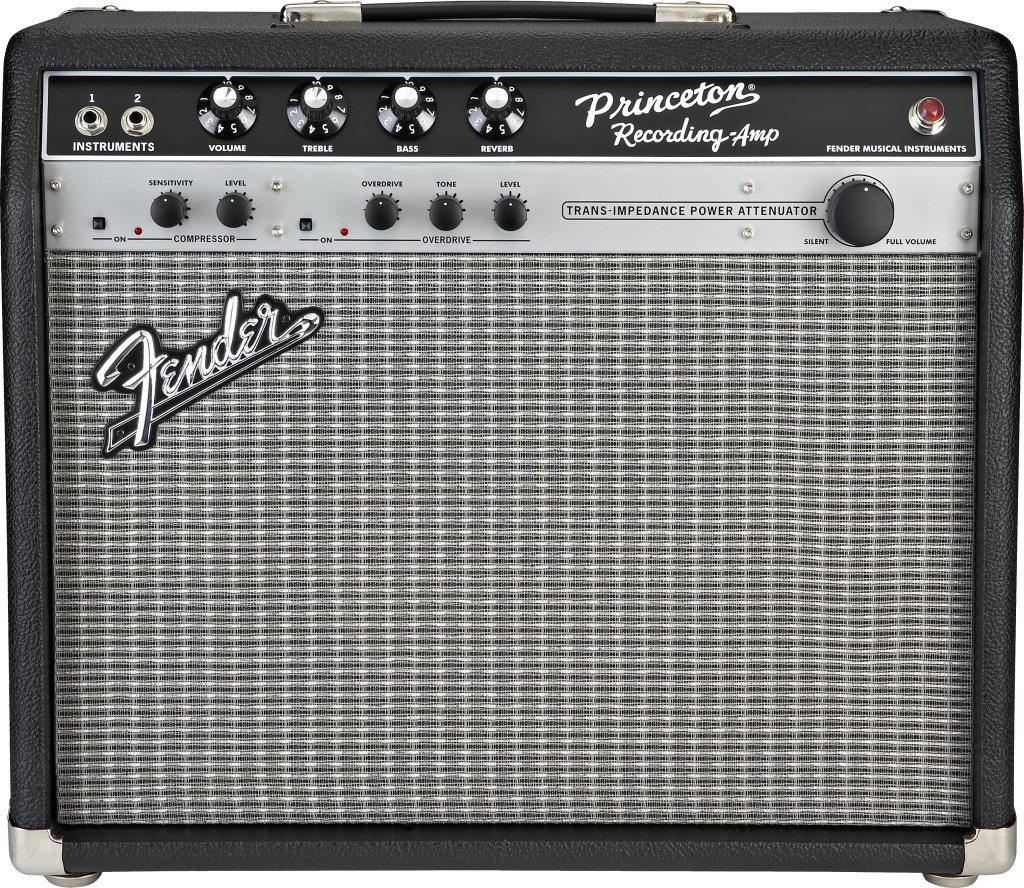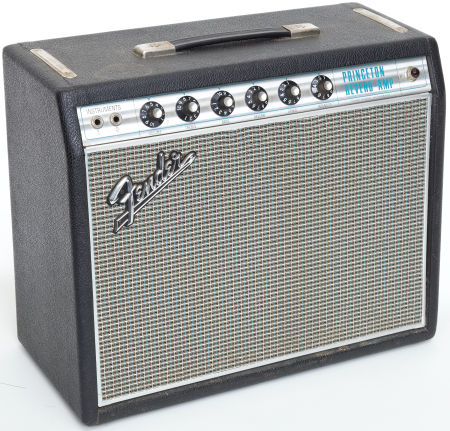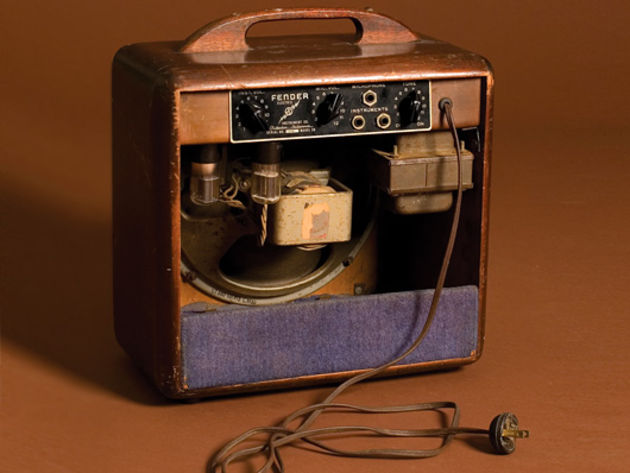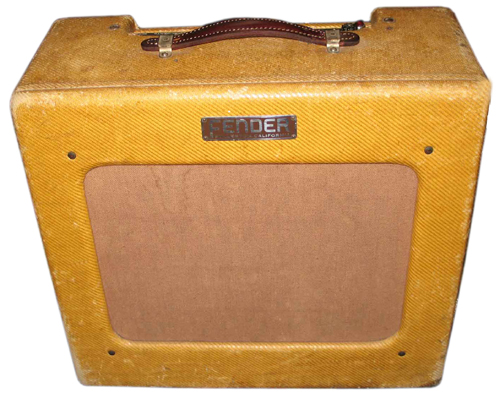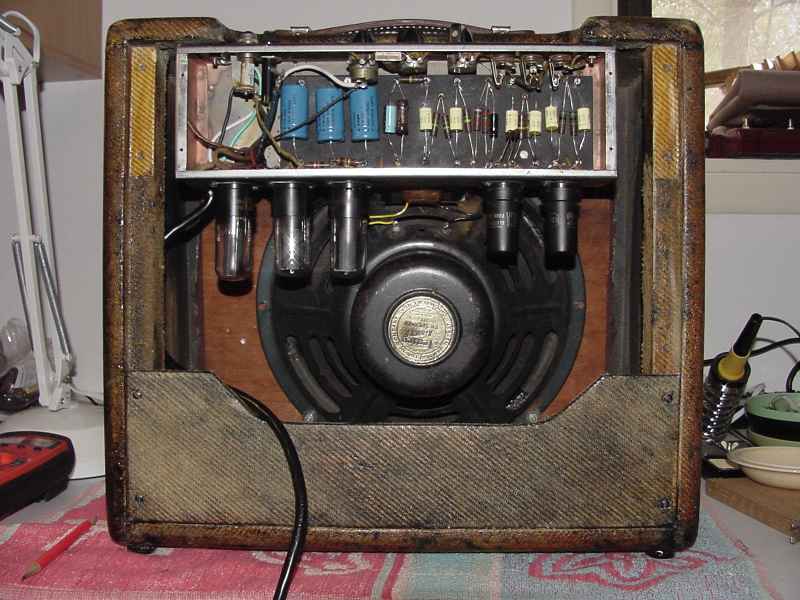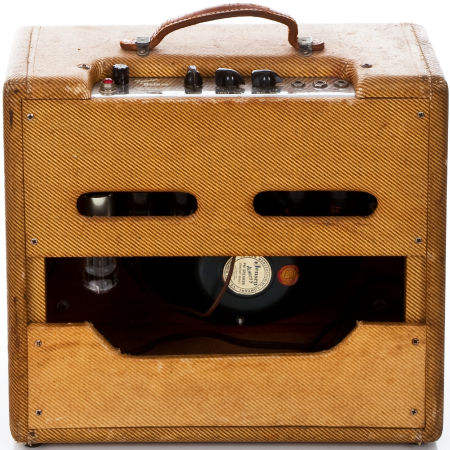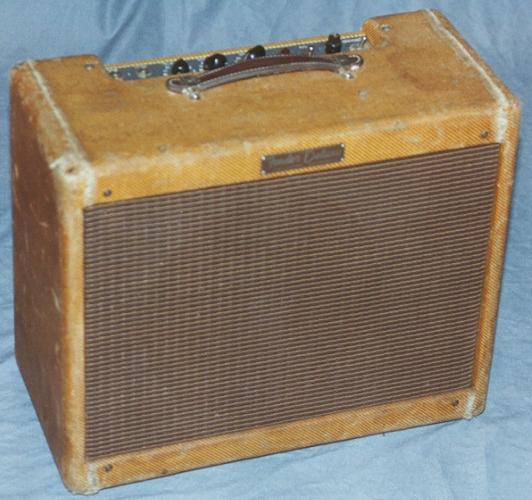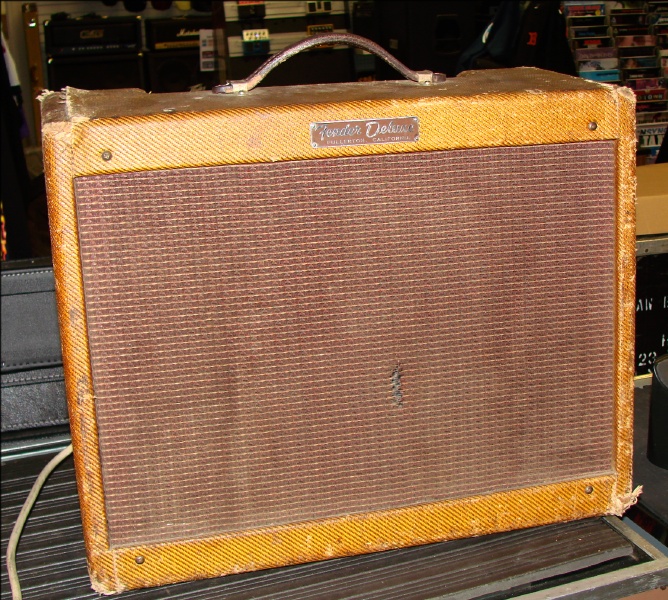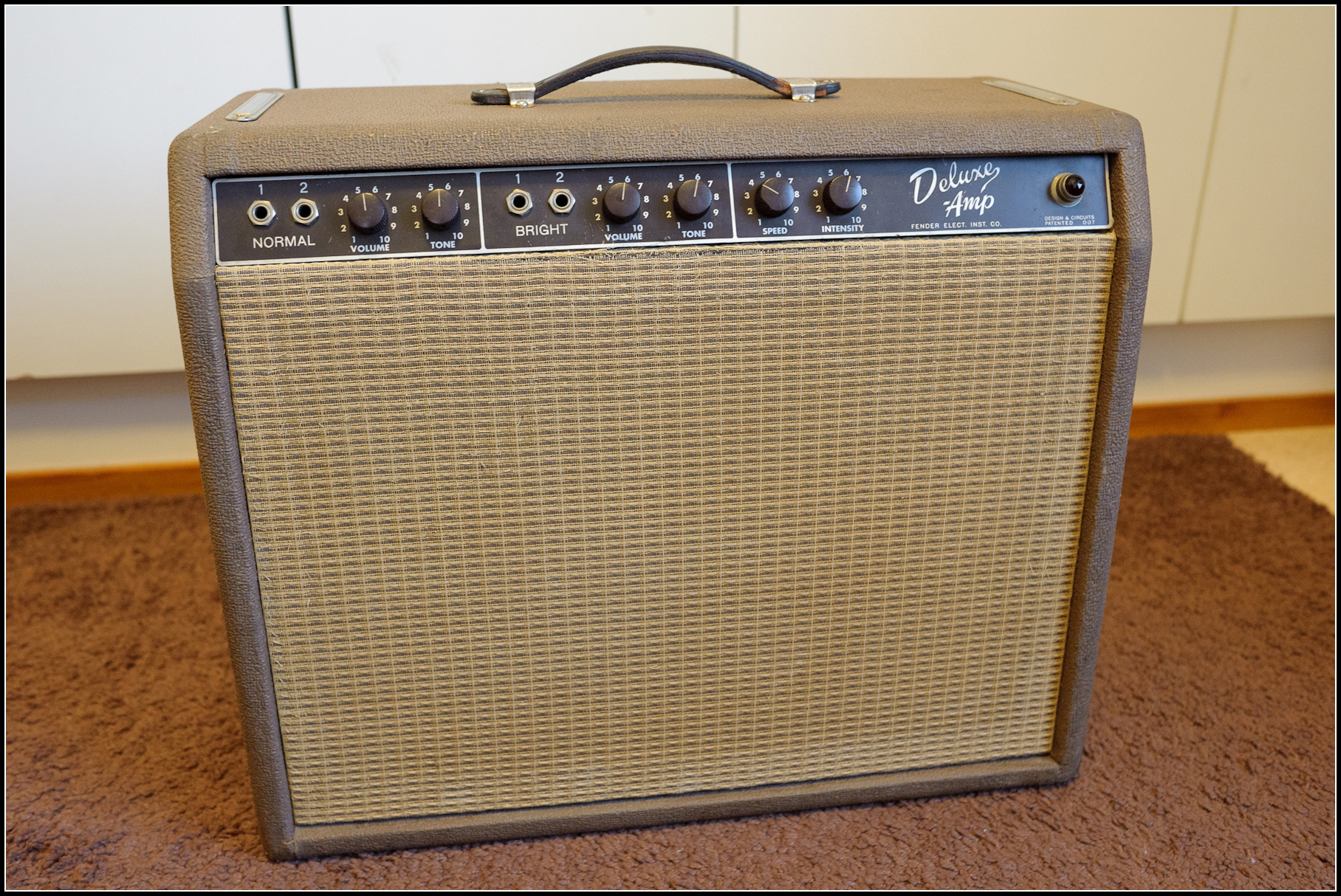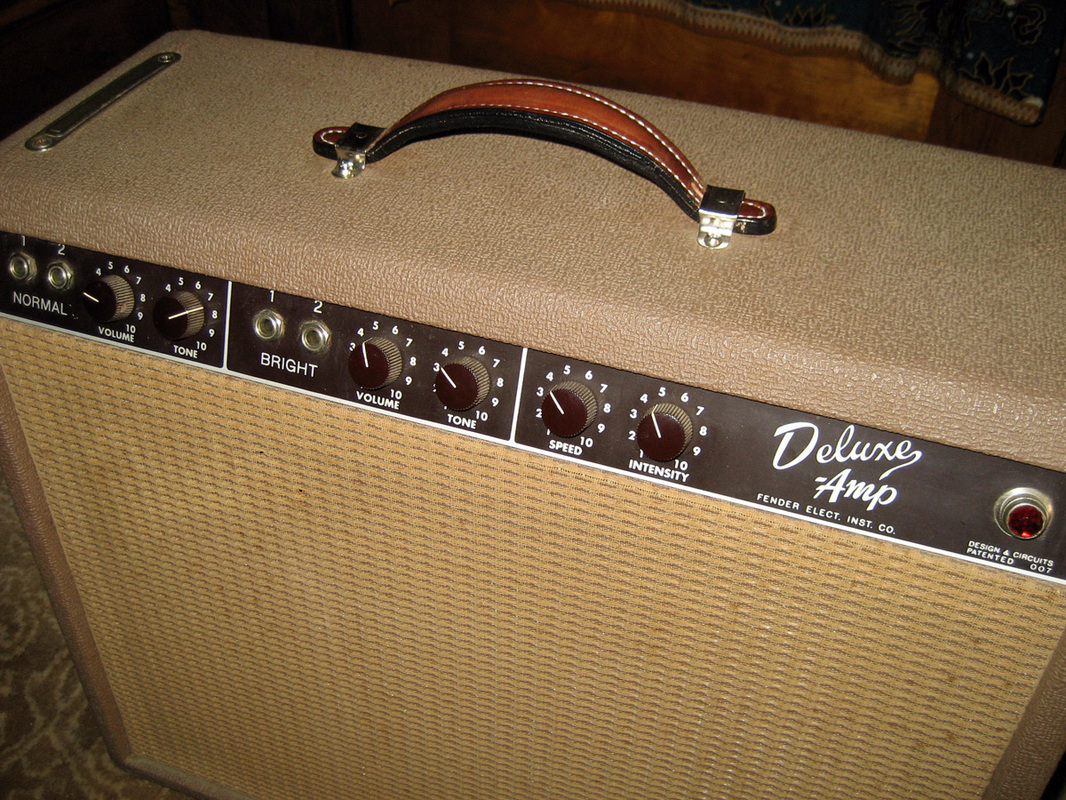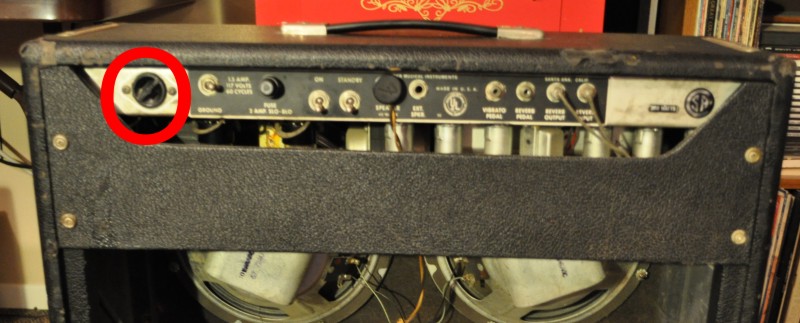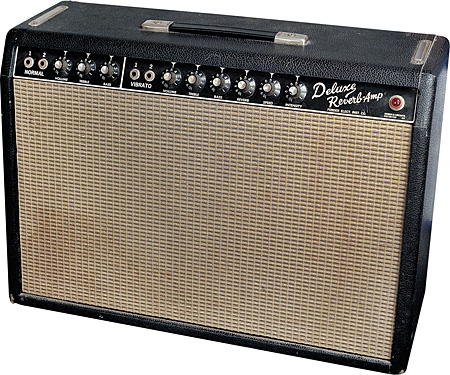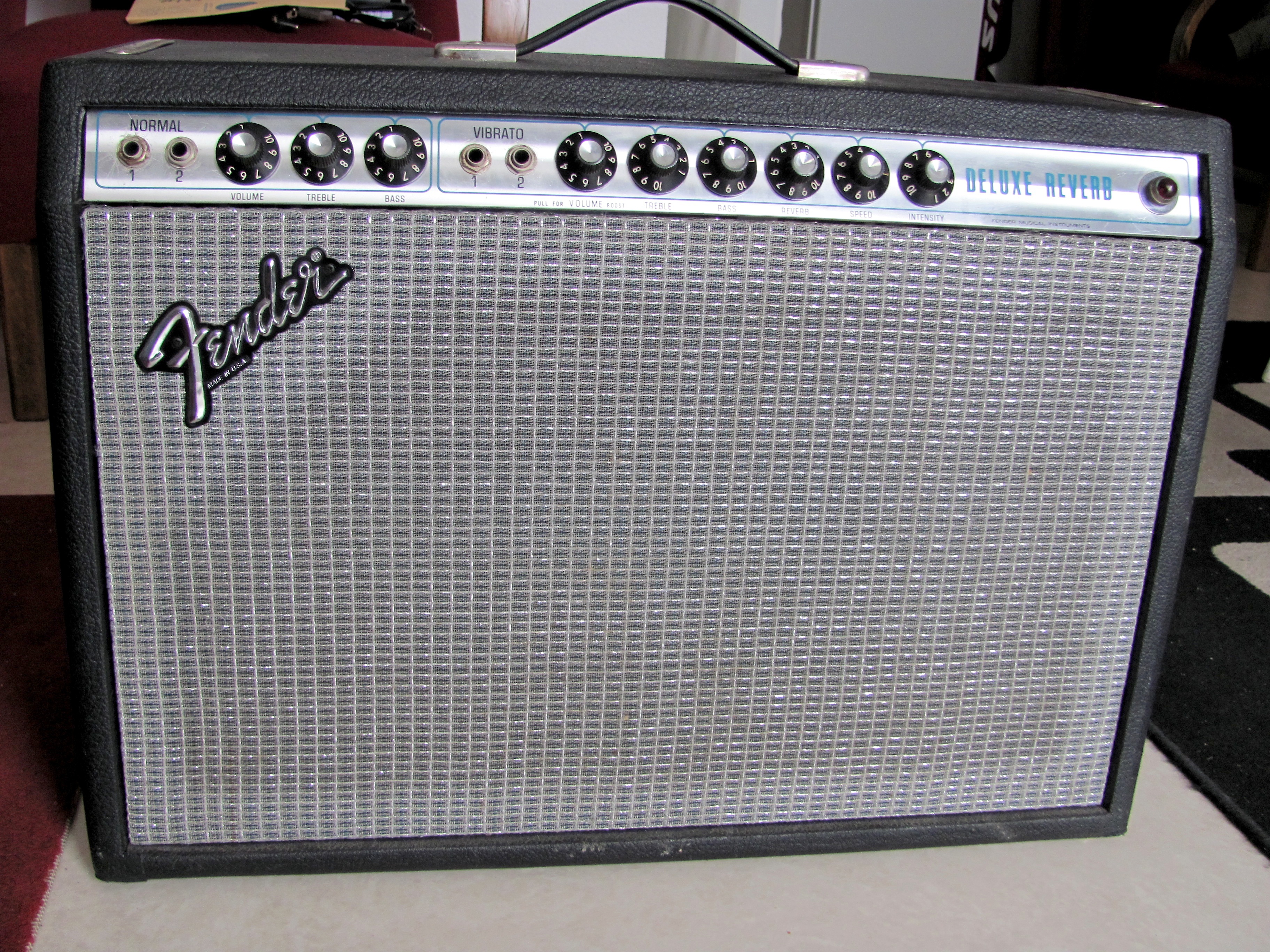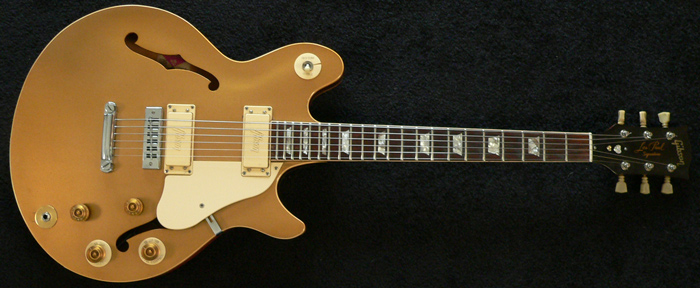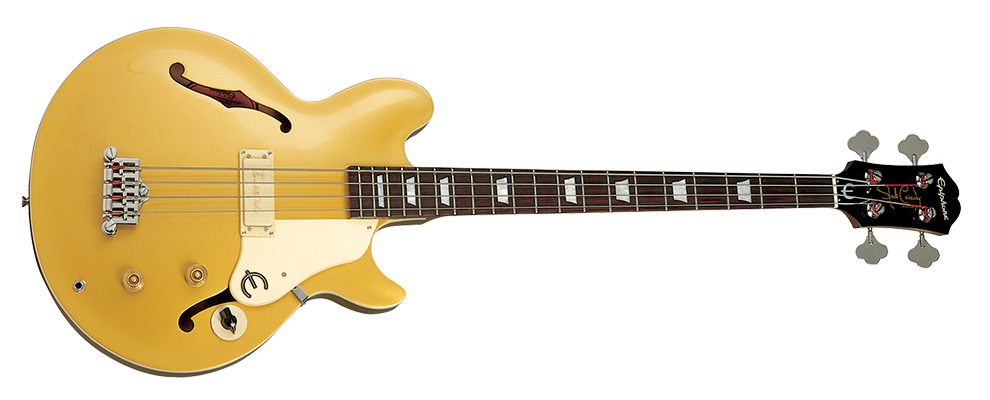In 1946 Leo Fender offered the Model 26 as his “Deluxe” amplifier for sale. This was a very basic amp. It produced around 10 to 14 watts of power, which was loud enough to let the guitar be heard in most of the bands and orchestras of the day.
Though Leo Fender and other amp designers of the day had a perception of their amplifiers remaining clean at high volumes, many musicians had other ideas.
The tube driven saturation of a cranked Deluxe amp was favored during the 50’s and in subsequent decades as it is still favored today.
![]() |
| 1947 Model 26 |
The original Deluxe amp or Model 26 was what we today consider to be a “Woody”. The amplifier was housed in a wooden chassis made of maple, walnut or mahogany, whatever wood was available at the time. The handle was also fashioned of wood.
![]() |
| 1946 Model 26 Rear |
The grill covering was made of fabric that could be gold, red or blue and there were two to three vertical chrome stripes on the face of the grill cloth. This amp housed a 10” Jensen speaker. For the first year this was a field coil type speaker, with the output transformer mounted on the chassis.
Then beginning in 1947 Fender switched to a fixed magnetic speaker which had the output transformer mounted on the speaker basket.
The Model 26 controls were mounted on the back panel and very straight forward; an instrument volume control and a mic volume control, both of which went from 1 to 12, one mic input and two instrument inputs and a single tone potentiometer.
![]() |
| Metal envelope tubes |
The tube complement consisted of two metal envelope 6V6 power tubes, one 6SN7 metal envelope tube used as a preamp and a metal envelope 6N7 used as the phase inverter and 5Y3 glass envelope tube as the rectifier.
Metal envelope tubes were a popular style in those days.
This was a cathode biased amplifier. Cathode biasing provides a steady negative DC bias voltage on the control grid of the vacuum tubes.
I think some of the charm of the Deluxe line of Fender amps stems from the fact that they are cathode biased.
![]() |
| 1946 Fender Deluxe 5A3 |
The second version of this amp and the first Fender amp that Leo named
The Deluxe was the model 5A3. This is sometimes referred to as the TV Front amp since it resembled a TV set from the 1950’s. The Deluxe amplifier went into production in 1948 and remained in the line-up for the next five years.
Like the Model 26, the 5A3 pumped out 10 to 14 watts. However the speaker size was increased to 12” with an 8 ohm load. It was also made by the Jensen Company.
The chassis on the TV front Deluxe was made of pine and covered with tweed material made out of varnished cotton cloth. The brown colored grill was originally made of mohair in 1948, but linen cloth was used in subsequent years. Instead of wood, the handle on this model was made of leather secured with two glides.
The amplifiers control panel was moved to the top of the amplifier. Instead of a black panel which was on the Model 26,. the control panel on this amplifier came with a classy chrome cover and it included controls for Volume, Mic Volume, Tone (which was also an on/off switch) and two instrument inputs and a mic input.
The front of the amp had a rectangular badge proclaiming it to be Fender - Fullerton California.
![]() |
| 1951 Deluxe 5A3 |
The tube compliment included 2 metal envelope 6V6 power tubes, a 6NS7 preamp tube, part of a another 6SC7 tube was used as a phase inverter, while a metal envelope 5Y3 was used as the rectifier. Like the Model 26, this amp was cathode biased. It remained in the Fender line-up through 1953.
![]() |
| 1953 Deluxe 5B3 |
It was in that same year, 1953, when the design was once again changed. Depending on the year this could be the model 5B3,
5C3, or 5D3. All are commonly identified as the Wide Panel Deluxe amp.
Like its predecessor, this amp was covered in varnished tweed material and had a leather handle. On its front was the familiar rectangular Fender badge.
The Wide Panel Deluxe amp came with a 12” Jensen 8 ohm speaker which pumped out 10 to 14 watts.
The controls were in fact similar to the TV front version; Volume, Mic Volume, and a Tone knob that doubled as an on/off switch. This amplifier possessed two inputs labeled Instruments and one labeled Mic.
Like the model 5A3 and the model 26 the knobs were numbered 1 through 12. The grill covering on this series was dark brown linen.
The tube compliment had changed somewhat. The metal envelope tubes were now gone and instead the more modern glass tubes or GT models were utilized. Two 6V6GT’s handled the power duties. The preamp tube of choice for models 5B3 amd 5C3 were 6SC7’s and a 12AX7 for the model 5D3.
A 6SC7 was used as a phase inverter on the 5B3 and 5C3 designs, while a 12AX7 was utilized for this purpose in the model 5D3. The rectifier tube for all models was the 5Y3GT.
The model 5B3 was essentially the same amplifier as the 5A3, but for cabinet. which no longer had the "TV" front. In later years it came to be known as the Wide Panel Deluxe.
The model 5C3 included an additional on/off toggle switch, a negative feedback loop and there was a now a jack for the speaker wires which was positioned on the bottom of the amps chassis.
![]() |
| '55 5D3 note the badge |
The 5D3 was similar to the 5C3, but there was no negative feedback loop.
As a brief explanation, a negative feedback loop flattens and extends the frequency response. This makes the sound cleaner with less distortion giving the sound a more “hi-fi” feel. The downside is that it effects the tone.
And when the amp is overdriven there is more clipping. There are advantages and disadvantages to the negative feedback loop. Something happened during the end of the run of this amplifier. For whatever reason the negative feedback loop was eliminated in the last model, the 5D3 version.
![]() |
| 1958 Fender Deluxe 5E3 |
The next version of the
Deluxe Amp is the Narrow Panel model also known as the 5E3 model. The 12” Jensen 8 ohm speaker remained as a standard for this amplifier. However the RMS output was upped to 15 watts in this model.
![]() |
| 1959 Fender Deluxe 5E3 |
Once again this amplifier was covered in varnished tweed cloth. It came with a leather handle that had glides on either side. The speaker covering or grill cloth was usually dark brown linen.
![]() |
| 1960 Fender 5E3 |
The amplifiers control panel was mounted towards the rear of the amps top and once again had a chromed covering.
The controls included a ground switch and a power switch, a volume potentiometer, a mic volume pontentiometer, a single tone potentiometer and two instrument inputs and two mic inputs.
A speaker and an external speaker jack were mounted on the bottom of the chassis that held the electronics.
Once again twin 6V6GT’s (glass tubes) were the choice for power tubes. The rectifier was a 5Y3GT. A 12AY7 and 1/2 of a 12AX7 were used for the preamp circuit, while the other 1/2 of the 12AX7 was utilized for phase inversion.
The rectangular badge on the amp proclaimed it to be a Fender in block letters.
Later runs of the amp came with badges that said Fender Deluxe in the same font that Fender would bein to use for years to come. The words Fullerton California were written in block lettering below.
The 53E model remained in the line-up from 1955 to 1960 and today is still a very popular and imitated model.
![]() |
| 1961 Fender Deluxe 6G3 |
In 1961,
the year you could read right-side up or upside down, The Fender Deluxe Amp was radically redesigned. This was the
Brownface Deluxe also known as model 6G3. The amplifiers control panel was no longer on the top and it now faced front and came with a dark brown face-plate. In some cases this was almost black.
The amplifiers cabinet was now covered in a sandy coloured brown vinyl material called Tolex.
Tolex is a material created by the General Tire Company and was originally designed for use in upholstering the Henny-Packard (Packard was an old brand of automobiles) hearses and ambulances and in
Chris Craft boats.![]() |
| 1961 Fender 6G3 |
This amplifiers speaker baffle was covered in a woven material we commonly call grill cloth. In this case it was of a wheat coloured design. The handle was made of leather with metal glides. The amp unit was secured to the top of the amp with two chrome metal “straps”.
This was the first Deluxe amp to have two distinct channels. One was labeled normal and the second labeled bright. On the earliest models the bright channel was on the left, but this was soon reversed. Each channel had two inputs and a single volume and a single tone knob.
![]() |
| 1962 Fender 6G3 |
This was also the first amp in the Deluxe series to have a built-in special effect, which was labeled vibrato, However it was actually a tremolo circuit and it was powered by one half of a 12AX7 tube which worked as an oscillator. The vibrato circuit was controlled by the familiar speed and intensity potentiometers.
The circuitry in this model was completely redesigned so the output was bumped up to 22 watts.
The amps speaker was 12” with an 8 ohm load, but was now made by Oxford instead of Jensen. On the earliest models the speaker screwed into the baffle from the front of the baffle board. This soon changed and the speaker screwed in from the backside.
Once again the power tubes were twin 6V6GT models. The rectifier tube was changed to a GZ34. A single 12AX7 was used as a phase inverter. The preamp section included half of a 7025 for the normal channel and the other half used for the bright channel. And as mentioned before 1/2 of a 12AX7 was used for the tremolo.
This version of the Deluxe Amp remained in the line up through 1963.
By 1963 the Fender Deluxe amp underwent another redesign.
This was the model AA763. The tolex covering was now black, which matched the face-plate on the control panel. The grill covering was either grey or grey with silver sparkles. The handle was no longer made of leather, but of a black vinyl material with chromed glides.
![]() |
| 1965 Fender AA763 |
The AA763 circuit was modified. This amp also included two separate channels. Each had controls for Volume, Treble and Bass. Each channel had two instrument inputs. The first input has a bit more gain on it and is useful for single coil pickups.
I have read the second input has about a 6 db drop and can be used for humbuckers or effects pedals. I have noticed on my Fender amps the #1 input provides a bit more power.
![]() |
| Deluxe AA763 |
Channel one was labeled Normal, while channel two is labeled as Vibrato. Channel two, which was a little brighter and it included two controls for tremolo; speed and intensity.
This version of the Deluxe amp pumped 22 watts into a 12” 8 ohm Oxford speaker. The power tubes were 6V6GT models.
The rectifier was a GZ34 and the preamp section was powered by two 7025 tubes. One was for the Normal channel and the other for the Vibrato/Bright channel. A 12AT7 tube was used as a phase inverter for the power tubes and a 12AX7 powered the tremolo effects. The Deluxe amp was one of the first Fender amps to include an adjustable bias potentiometer although the amp did have a fixed bias.
The controls on the back of the amp included a 2 prong “courtesy outlet”, a “ground” switch, a power switch, a standby switch, a speaker input jack, an external speaker jack and an input for the vibrato/tremolo foot pedal.
Briefly, here are a few words regarding the electric outlet found on the back of 1960’s Fender amps; This feature appeared prior to the age of 3 prong electric plugs and “snake” electric cables that are used these days by most bands.
Back in the day we used to just plug one or two amps into the electric service outlets at a club and plug our buddies amp into the back of ours. We hoped the polarity was correct so we didn’t get shocked if we touched each other. So the "courtesy" outlet was a great feature in the 1960's.
Which brings me to the “ground” switch. In days of old most electric services in homes and clubs had 2 prong outlets. Believe it or not, the blades on electric plugs were both the same size.
So if you had a lot of buzzing in you amp, or if you touched the mic and got shocked because the PA was running on a different polarity you had two choices; pull the electric plug out and flip it one half turn and plug it back in or flip the ground switch on your Fender amp.
Later on when 3 prong outlets became the norm, some newer amps came with ground switches, but this was just a feature to reduce the 60 cycle hum.. If you have an older Fender amp with a 2 prong electric plug I suggest that you get it converted to a three prong plug.
The Fender Deluxe amp remained in the line up through 1966 when it was officially retired.
![]() |
| Deluxe Reverb model AB763 |
In 1963, during this same time period as the Fender Deluxe amp, Fender produced one of their most popular amplifiers and in my opinion best amps ever. This was the Blackface Deluxe Reverb also known as
the model AB763.This amplifiers wooden cabinet was covered with black tolex and the grill covering in front of the speaker baffle was grey or silver sparkle woven material. The 12" 8 ohm speaker was a Fender Special design model made by Oxford.
The handle on this amplifier was made of black reinforced vinyl with chrome glides.
This was the first year the amp came with the well known
Fender badge and this one had a tail from the last “r” that went underneath the word “Fender.” The badge was mounted on the side of the grill.
Like the previous model, this was a two channel amplifier. The first or Normal channel came with two inputs, one volume control, one treble control and one bass control. Once again the first input provided a little more gain than the second. The second channel, labeled Vibrato also had two instrument input jacks, one volume, one treble and one bass control. Next came the vibrato controls; speed and intensity, and finally a single potentiometer to adjust the reverb level. The knobs were all mounted on a black metal panel with the familiar Fender script.
The back panel, from left to right, consisted of the courtesy electrical two-prong outlet, the ground switch, the fuse, a power switch, a standby switch, the speaker jack, an external speaker jack, followed by two plug-in jacks for the vibrato and reverb pedal and finally two more plugs for the reverb output and reverb input for the wires coming out of the reverb tank which was mounted in a bag on the floor of the amps cabinet.
The amps power section was run by twin 6V6GT tubes, while the preamp normal channel ran off of a 7025 tube. The vibrato channel ran off of two 7025's, however only 1/2 of the second was utilized. The other half of this tube was used for reverb recovery.
A 12AT7 tube was used as a phase inverter. The rectifier was a GZ34 tube. The tremolo section was run by a 12AX7 and a 12AT7 was used as a reverb driver. This amp also had an adjustable bias potentiometer.
![]() |
| Original '65 Deluxe Reverb |
This amp pumped 22 watts into an 8 ohm speaker load. While it was not an overly loud amp, it can give wonderful clean sounds with lots of headroom especially when mic’d. And when overdriven at cranked levels, it breaks up nicely.
The Blackface Deluxe Reverb remained in the Fender line-up through 1967.
As you might recall, CBS purchased the Fender company in 1965, and part of the sale included a lot of left over stock so chances are if you have a Blackface Deluxe Reverb from that vintage it was more than likely a pre-CBS amplifier.
It was in 1968 that the Fender Deluxe Reverb underwent some more changes. This was the era of the Fender Silverface amps and the Deluxe Reverb was in the line up. This was also known as the model AB868.
Once again the cabinet was covered in black tolex. The front control panel had the same controls as the Blackface model and the twin channels remained. Although in 1977 the volume control on the Vibrato channel was changed from a standard potentiometer to one that had a dual function. You could pull it forward to activate a volume boost.
The facade for the control panel was now finished in translucent silver. Instead of the familiar Fender font stating “Deluxe Reverb”, the font used now was light blue block lettering.
The only change on the back panel was that the AC outlet was switched to a 3 prong version. The other controls remained the same as the Blackface model, except in 1979 a line out jack was added. The speaker was generally made by Oxford, however Fender also used Utah speakers.
![]() |
| '69 model with aluminum frame |
The baffle on the amps grill changed through the years. From 1968-69 the grill covering was a woven silvery-blue material with sparkles in it. These years there was an aluminum frame that bordered the grill section.
Starting in 1970 and lasting until 1975 the aluminum frame was no longer on the amp. Then in 1976 through the end of the run, in 1982, the grill cloth was made of a silver and orange woven material.
The amp retained the familiar Fender badge on the grill cloth and from 1968 through 1974 it had the “tail’. Sometime in 1974 the Fender badge was changed to a tailless version and this was the logo used until 1993 when Fender decided to recreate the “1965 Deluxe Reverb” and used the older badge with the tail.
The tubes in the Silverface Deluxe Reverb were virtually the same tubes used in the Blackface model with the exception of the rectifier, which was now a 5U4GB. The output on this model was still rated at 22 watts RMS.
![]() |
| 1980 Deluxe Reverb |
The Silverface control panel remained a mainstay on the Deluxe Reverb until 1980 when Fender reverted back to a black front cover. The font used on the 1980 model for the words Deluxe Reverb was not quite as fancy as in 1963.
But the the grill cloth on the 1980 Deluxe Reverb changed back to the silver sparkle woven pattern. The Silverface Deluxe Reverb and its newer Blackface predecessor ended their run in 1982.
In 1982 the Fender Deluxe Reverb underwent a very dramatic change thanks to amplifier designer Paul Rivera, who at the time was Fenders marketing director. This amp was known as the
Fender Deluxe Reverb II. Approximately 3,500 units were built.
The production history of this amp is interesting, but first here is a little about the amp.
The circuit was completely redesigned. This amp had the ability to get the normal Fender-style clean sound, but it also came with a switchable mid-range voiced gain channel. This feature was designed to compete with competitive amps built during this era, such as Mesa Boogie (which interestingly started out as a Fender Princeton Reverb).
On the Deluxe Reverb II, no longer were there two different individual and separate channels. This model came with two totally different channels that incorporated the possibility of switching sounds.
Guitar players in the late 1970's had experimented with ways to utilize the both channels on their Fender amps to get different and overdriven sounds. The Rivera/Fender amps were what they were dreaming about.
![]() |
| Paul Rivera |
The Deluxe Reverb II is a highly sought after amp since it features eyelet board construction and is pretty much hand-wired; and besides the fact that it was made by Paul Rivera.
From outward appearance this amplifier looked pretty much like a Blackface Deluxe Reverb. The cabinet was covered in black tolex and the speaker baffle was covered in blue/grey sparkle grill cloth. The front panel was black with two instrument inputs.
The words Deluxe Reverb II, in the stylized Fender font were on the face-plate.
From left to right the controls included a volume knob that could be pulled for a bright sound, followed by treble and bass knobs. Next came the gain channel with a volume control which could be pulled for channel selection, then a gain knob, a treble knob, a mid knob with a pull feature for a mid-range boost. Next came a bass knob, a reverb knob and finally a presence knob, which I am told worked great with distortion, followed by the power switch.
On the rear of the amp was a 3 prong electrical outlet, a 3-way “ground” switch which could be switched to the left, middle/off or right position, a speaker input, an external speaker input, two inputs for the amps pedals (channel switching and reverb), an input for reverb out and reverb in and a hum balance potentiometer, which was turned with a screwdriver. Tremolo was gone on this model.
![]() |
| Deluxe Reverb II replaced speaker |
The 12” 8 ohm speaker was a Fender Special design, probably made by Oxford and it pumped out 20 watts. Once again the power tubes were twin 6V6GT’s, the phase inverter was a 12AT7, the preamp tubes were three 7025’s, another 7025 was split and 1/2 was used for the preamp.
The other 1/2 of the 7025 was used for reverb recovery and one other 7025 was used as the reverb driver. The rectifier was solid-state for this model. The bias was fixed and was not adjustable.
The Deluxe Reverb II and others in the Rivera series were special amps because these were the last of the amps made at the Fullerton California facility.
![]() |
| William Schults |
In 1985 William Schultz led a group of employees and investors in the purchase of the Fender Company from CBS. I cannot say enough wonderful things about Bill Schultz. He can be credited with saving and rebuilding the Fender name. Mr. Schultz spent much of his career in the musical instrument industry and was working for Yamaha before going out on his own.
![]() |
| Bill Schultz and Bill Mendello |
Many employees, including William Mendello, the company president stayed on and continued their work at Fender after the sale because of Schultz..
![]() |
| Fender Fullerton Factory |
The Fullerton facility was not included in the sale, so from 1985 to 1987 Fender or the Fender Musical Instrument Corporation as it was and is now known did not have a United States based facility. During this two year period amplifiers were assembled from pre-existing wired-up chassis in a rented facility in Brea California. As orders came in speaker and cabinets were made to conserve on space.
The Deluxe Reverb II and the other Paul Rivera designed amps ended their run in 1986. This would be the last of the Deluxe amplifiers until 1993 when Fender recreated the
‘65 Deluxe Reverb amplifier.The '65 Deluxe Reverb was a very similar amplifier, especially in appearance, but the circuit board was modernized to a printed board and the speaker was now made by Eminence.
In 2014 Fender reissued the Silverface Custom Deluxe Reverb. The tone circuit in this model was modified.
The two channels are marked Custom and Vintage.
The Vintage channel or what we think of as the reverb side has more of a Bassman style tone circuit, while the first channel, now marked Vintage has more of a vintage tone stack on the normal side. But both sides now share reverb and tremolo. The negative feedback loop was removed from the circuit so the amp has more bite and grit. The speaker in this model is a Celestion.






